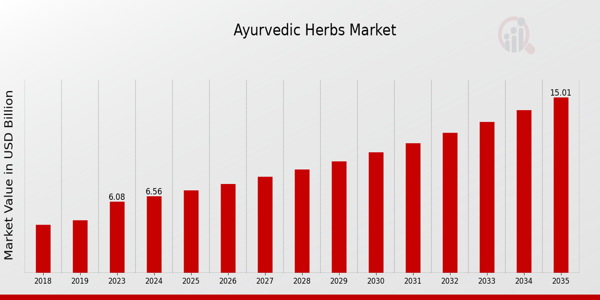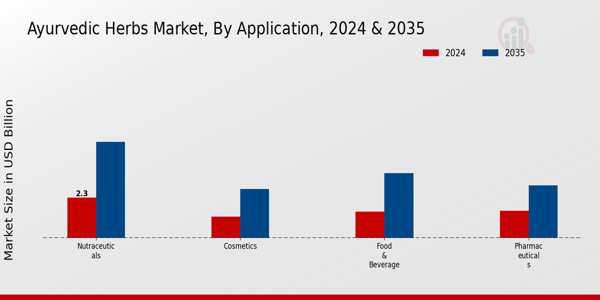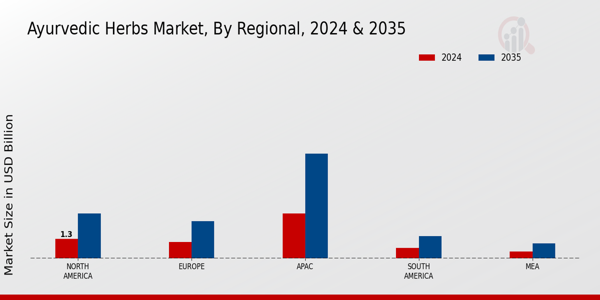Ayurvedic Herbs Market Overview
As per MRFR analysis, the Ayurvedic Herbs Market Size was estimated at 6.08 (USD Billion) in 2023.The Ayurvedic Herbs Market is expected to grow from 6.56(USD Billion) in 2024 to 15.0 (USD Billion) by 2035. The Ayurvedic Herbs Market CAGR (growth rate) is expected to be around 7.82% during the forecast period (2025 - 2035).
Key Ayurvedic Herbs Market Trends Highlighted
A growing awareness of natural and holistic health options is propelling the global market for ayurvedic herbs. Ayurvedic goods are becoming more and more popular among consumers because of their alleged advantages, which include enhancing general health and treating a range of medical conditions without the negative side effects frequently connected to synthetic drugs.
This tendency is further supported by the increasing focus on preventative healthcare and the move toward incorporating traditional methods into contemporary wellness routines. Customers are looking for natural therapies that fit with their interests in organic and sustainable solutions as their lives get busy.
There are numerous opportunities within the market that can be explored. Companies can focus on innovative product development, tailoring offerings to specific consumer needs such as stress relief, digestive health, and immunity enhancement. Moreover, increasing demand for herbal dietary supplements presents avenues for expansion.
Collaborations with wellness centers and the integration of Ayurvedic principles into fitness and dietary programs can also drive growth. As more people look for alternatives to conventional health products, the exploration of e-commerce platforms can widen market reach and improve accessibility to Ayurvedic herbs.
Recent trends indicate a rising interest in herbal products among younger consumers, who are increasingly drawn to natural wellness options. Social media and online communities are playing a pivotal role in spreading awareness and educating the public about the benefits of Ayurvedic practices.
Additionally, the trend toward personalized health solutions has led to a growing demand for customized Ayurvedic products that align with individual health profiles and preferences. As the market continues to evolve, the synergy between traditional knowledge and modern consumer behavior is likely to shape the future landscape of the Ayurvedic herbs industry.

Source: Primary Research, Secondary Research, MRFR Database and Analyst Review
Ayurvedic Herbs Market Drivers
Growing Awareness of Health and Wellness
The Global Ayurvedic Herbs Market is witnessing a significant rise in awareness regarding health and wellness among consumers. As people become more health-conscious, there is an increasing shift towards natural and herbal products.
This trend is deeply rooted in the importance placed on holistic health, with Ayurveda being a key player in this movement. Ayurvedic principles emphasize balance and prevention, which resonates with a large segment of the population looking for alternative methods to manage their health.
In recent years, healthcare practitioners, wellness influencers, and educational campaigns have made significant strides in promoting the benefits of Ayurvedic practices and herbal remedies. Consumers are now more inclined to seek natural treatments for various conditions, including digestive issues, stress management, and skin health.
This growing preference is further fueled by the availability of information on the efficacy and benefits of Ayurvedic herbs through social media, wellness blogs, and educational platforms.
The Global Ayurvedic Herbs Market is thus positioned to benefit from this heightened interest, as more individuals are actively integrating Ayurvedic herbs into their daily routines, seeking them as safe and effective alternatives to conventional medicine.
Increased Demand for Natural Ingredients
There is a noticeable shift towards natural ingredients in the beauty, health, and food sectors, which is propelling the growth of the Global Ayurvedic Herbs Market.
As consumers become more aware of the side effects associated with synthetic ingredients, they are actively seeking out natural and organic alternatives. This shift is rooted in the perception that natural ingredients are safer, more effective, and better for long-term health.
Brands are taking notice and reformulating their products to incorporate Ayurvedic herbs, which not only enhance the product's appeal but also align with the growing consumer demand for transparency and sustainability in their purchases. This trend towards natural ingredients not only enhances market growth but also reinforces consumer trust in products made with Ayurvedic herbs.
Rising Popularity of Preventive Healthcare
Preventive healthcare is becoming a priority for consumers worldwide, which is greatly influencing the Global Ayurvedic Herbs Market. People are increasingly focusing on maintaining their health instead of merely treating illnesses.
Ayurvedic herbs are well-known for their preventive properties, making them an attractive option for health-conscious consumers. Traditional Ayurvedic practices stress the importance of regular health maintenance and the use of natural herbs to support overall wellness.
The growing cost of healthcare and a shift towards self-care are contributing factors, driving individuals to turn to Ayurvedic remedies as viable alternatives. This trend emphasizes the relevance of Ayurvedic herbs in a proactive health strategy, further bolstering market expansion.
Ayurvedic Herbs Market Segment Insights :
Ayurvedic Herbs Market Application Insights
The Global Ayurvedic Herbs Market showcased a diverse range of applications, with appreciable growth in multiple segments that demonstrate significant market potential.
Notably, the application of Ayurvedic herbs played a crucial role across various industries, prominently in Nutraceuticals, Cosmetics, Food Beverage, and Pharmaceuticals, each contributing to the market's expansion by catering to health-conscious consumers and individuals seeking natural remedies.
The Nutraceuticals segment led with a valuation of 2.3 USD Billion in 2024, demonstrating its majority holding in the market due to rising preferences for dietary supplements and functional foods, which were increasingly integrated with Ayurvedic principles aimed at promoting wellness and prevention of chronic diseases.
Following this, the Cosmetics segment steadily gained traction, registering a market value of 1.2 USD Billion in 2024, propelled by consumer interest in natural beauty products. The increasing awareness of the harmful chemicals present in conventional beauty items positions Ayurvedic cosmetic products as a preferable alternative, which enhances the segment's growth trajectory.
The Food Beverage segment, valued at 1.5 USD Billion in 2024, also played a vital role as consumers increasingly sought healthy food choices that incorporate Ayurvedic herbs for their nutritional benefits and holistic approach to well-being.
Meanwhile, the pharmaceuticals segment, valued at 1.56 USD Billion in 2024, highlighted the growing recognition of Ayurvedic herbs in modern medicine, where these natural remedies are finding their place in preventive healthcare solutions.
Each of these segments thrived on a general trend favoring holistic health and well-being, made prominent by a shift towards natural ingredients across various consumer products. The continued focus on natural health solutions is likely to sustain market growth, revealing ample opportunities for innovation and expansion within the Global Ayurvedic Herbs Market.

Source: Primary Research, Secondary Research, MRFR Database and Analyst Review
Ayurvedic Herbs Market Form Insights
The Global Ayurvedic Herbs Market has shown considerable growth, driven by increasing consumer awareness about natural products and holistic healing practices. The market segmentation concerning form includes key categories such as Powder, Liquid, Capsules, and Tablets, which cater to diverse consumer preferences and usages.
Powders dominate this segment due to their versatility and ease of incorporation into dietary routines. Liquid forms are gaining traction given their perceived bioavailability and quicker absorption in the body, making them a favorable choice for many users.
Capsules and Tablets, on the other hand, are significant for their convenience and consistent dosage, appealing particularly to consumers seeking straightforward supplements. The overall market growth is supported by a rising trend towards preventive healthcare and an increasing prevalence of chronic diseases, yet challenges such as regulatory barriers and quality assurance persist.
There are abundant opportunities within the Global Ayurvedic Herbs Market as wellness tourism and the shift towards organic products flourish, promising a robust future for various forms of Ayurvedic herbs in the health and wellness industry.
Ayurvedic Herbs Market Source Insights
When analyzing the market segmentation by Source, various components such as Roots, Leaves, Flowers, and Seeds play crucial roles. Roots hold considerable importance in traditional Ayurvedic practices, primarily due to their medicinal properties and extensive use in various formulations. Leaves often dominate due to their easy availability and effectiveness, making them a staple in herbal remedies.
Flowers, though lesser in volume, contribute significantly to the market due to their unique phytochemical properties and uses in cosmetics and health supplements. Seeds serve as a vital source of nutrition and are integral in promoting overall health, thereby enhancing their market presence.
The growing inclination towards herbal products presents ample opportunities for innovation and expansion within these segments. Overall, the Global Ayurvedic Herbs Market data reflects a robust landscape, with diverse sources contributing to its steady growth trajectory.
Ayurvedic Herbs Market Distribution Channel Insights
Notably, online channels have gained immense popularity, allowing consumers easier access to a wide variety of products, which significantly contributes to market growth. Offline channels, including pharmacies and health stores, remain crucial as they offer personal engagement and customer service.
Pharmacies provide a trusted environment for consumers seeking Ayurvedic solutions, while health stores often focus on natural and organic offerings, aligning with health-conscious trends. As more consumers turn to Ayurvedic herbs for their health benefits, the distribution channels adapt to meet these demands, solidifying their roles in the overall Global Ayurvedic Herbs Market segmentation.
With market growth driven by increased awareness and acceptance of Ayurvedic products, challenges such as regulatory compliance and market competition emerge, underlining the importance of effective distribution strategies to harness opportunities in this expanding industry.
The overall Global Ayurvedic Herbs Market data indicates a promising trajectory for each channel as it aligns with the increasing interest in natural wellness solutions.
Ayurvedic Herbs Market Regional Insights
The Global Ayurvedic Herbs Market revenue was prominently shaped by its regional segmentation, reflecting the diverse adoption and growth dynamics across various areas. In 2024, the North America segment valued at 1.3 USD Billion and is projected to reach 3.0 USD Billion by 2035, indicating a significant market growth driven by increasing health consciousness and natural remedies popularity.
Europe followed closely with a valuation of 1.1 USD Billion in 2024, expanding to 2.5 USD Billion by 2035, supported by a growing trend towards herbal products and holistic wellness.
The APAC region dominated the market with a robust value of 3.0 USD Billion in 2024, expected to surge to 7.0 USD Billion in 2035, reflecting the region’s deep-rooted cultural practices and an increasing consumer base seeking Ayurvedic solutions.
South America, while smaller, still showed promise with 0.7 USD Billion in 2024, growing to 1.5 USD Billion by 2035, driven by an uptick in demand for organic products. Lastly, the MEA segment pegged at 0.46 USD Billion in 2024, is anticipated to grow to 1.0 USD Billion by 2035, highlighting a gradual acceptance of Ayurveda as a complementary health solution amidst a rising inclination towards herbal remedies.
The diversified nature of the Global Ayurvedic Herbs Market segmentation offered numerous growth opportunities tailored to regional consumer demands and preferences.

Source: Primary Research, Secondary Research, MRFR Database and Analyst Review
Ayurvedic Herbs Market Key Players and Competitive Insights :
The Global Ayurvedic Herbs Market is witnessing a dynamic landscape characterized by growing consumer awareness regarding natural and herbal products. This market is driven by an increasing trend toward holistic health and wellness solutions, fueled by the rising popularity of Ayurvedic practices worldwide.
Competition in the market is intensifying as various players strive to establish a foothold, emphasizing the importance of product quality, authenticity, and efficacy. Companies are keen on leveraging their unique strengths, including a strong brand presence, extensive distribution networks, and product innovation, to cater to the diverse preferences of consumers interested in Ayurvedic herbs.
The market dynamics are also influenced by shifting consumer behavior toward organic and sustainable sourcing, which has catalyzed significant investments in RD and marketing strategies aimed at differentiating products in a crowded landscape.
Dabur stands as a formidable player in the Global Ayurvedic Herbs Market, backed by a rich heritage and decades of expertise in the Ayurvedic sector. The company’s robust portfolio includes a wide range of herbal products that have established a strong brand loyalty among consumers.
Dabur’s strengths lie in its extensive distribution network, which spans both urban and rural regions, allowing for better market penetration and accessibility. The company’s commitment to quality control and sustainable sourcing enhances its reputation, ensuring that consumers trust the safety and efficacy of its products.
With continuous innovation and development of new herbal formulations, Dabur is well-positioned to adapt to changing market demands while maintaining a competitive edge. Zandu Realty is also a key player within the Global Ayurvedic Herbs Market, recognized for its deep-rooted connection to traditional Ayurvedic practices.
Zandu possesses a legacy of expertise in herbal formulations that resonate with health-conscious consumers. The company emphasizes authenticity and plays a significant role in preserving traditional methods while also incorporating modern scientific advancements into its product offerings.
Zandu’s strong brand equity, coupled with consumer trust in its high-quality products, enhances its competitive positioning. Its strategic initiatives focus on expanding its market presence through effective marketing campaigns and partnerships, thereby solidifying its role in promoting the benefits of Ayurvedic herbs globally.
Key Companies in the Ayurvedic Herbs Market Include:
- Dabur
- Zandu Realty
- Kottakkal Arya Vaidya Sala
- Baidyanath
- Madhavbaug
- Patanjali Ayurved
- Himalaya Wellness
- Sri Sri Tattva
- Elanic
- Brahmi Herbals
- Kerala Ayurveda
- Amrutanjan Health Care
- Khadi Natural
- Organic India
Ayurvedic Herbs Market Developments
The Global Ayurvedic Herbs Market is experiencing notable activity, particularly with companies like Dabur, Patanjali Ayurved, and Himalaya Wellness reporting strong growth in consumer demand for herbal products. Recent developments indicate increased investments from major players in expanding their product lines, aiming to cater to a rising preference for natural and organic solutions among consumers.
Zandu Realty and Kottakkal Arya Vaidya Sala are also enhancing their market presence through various initiatives aimed at improving distribution channels and increasing awareness about traditional remedies.
Merger and acquisition activities have garnered attention, with Baidyanath reportedly engaging in strategic partnerships to bolster its market position, while Madhavbaug and Sri Sri Tattva are exploring collaborative opportunities to enhance their operations.
Moreover, there is a significant rise in the valuation of these companies, driven by a growing acceptance of Ayurvedic practices in mainstream wellness. This growth trend emphasizes a shift towards holistic healthcare solutions, creating ample opportunities for innovation within the market.
Companies like Kerala Ayurveda, Amrutanjan Health Care, and Organic India are also playing pivotal roles in shaping the landscape of Ayurvedic products and herbal medicines globally.
Ayurvedic Herbs Market Segmentation Insights
Ayurvedic Herbs Market Application Outlook
- Nutraceuticals
- Cosmetics
- FoodBeverage
- Pharmaceuticals
Ayurvedic Herbs Market Form Outlook
Ayurvedic Herbs Market Source Outlook
- Roots
- Leaves
- Flowers
- Seeds
Ayurvedic Herbs Market Distribution Channel Outlook
- Online
- Offline
- Pharmacies
- Health Stores
Ayurvedic Herbs Market Regional Outlook
- North America
- Europe
- South America
- Asia Pacific
- Middle East and Africa
| Attribute/Metric Source: |
Details |
| MARKET SIZE 2023 |
6.08(USD Billion) |
| MARKET SIZE 2024 |
6.56(USD Billion) |
| MARKET SIZE 2035 |
15.0(USD Billion) |
| COMPOUND ANNUAL GROWTH RATE (CAGR) |
7.82% (2025 - 2035) |
| REPORT COVERAGE |
Revenue Forecast, Competitive Landscape, Growth Factors, and Trends |
| BASE YEAR |
2024 |
| MARKET FORECAST PERIOD |
2025 - 2035 |
| HISTORICAL DATA |
2019 - 2024 |
| MARKET FORECAST UNITS |
USD Billion |
| KEY COMPANIES PROFILED |
Dabur, Zandu Realty, Kottakkal Arya Vaidya Sala, Baidyanath, Madhavbaug, Patanjali Ayurved, Himalaya Wellness, Sri Sri Tattva, Elanic, Brahmi Herbals, Kerala Ayurveda, Amrutanjan Health Care, Khadi Natural, Organic India |
| SEGMENTS COVERED |
Application, Form, Source, Distribution Channel, Regional |
| KEY MARKET OPPORTUNITIES |
Rising consumer health awareness, Increasing demand for natural remedies, Expansion in e-commerce platforms, Growing popularity of personalized medicine, Strengthening regulatory support for herbal products |
| KEY MARKET DYNAMICS |
Rising consumer health awareness, Growing demand for natural products, Increasing online retail channels, Expanding applications in food and beverage, Government support for herbal industry |
| COUNTRIES COVERED |
North America, Europe, APAC, South America, MEA |
Frequently Asked Questions (FAQ) :
The Global Ayurvedic Herbs Market is expected to be valued at 6.56 USD Billion in 2024.
By 2035, the Global Ayurvedic Herbs Market is expected to reach a value of 15.0 USD Billion.
The expected CAGR for the Global Ayurvedic Herbs Market from 2025 to 2035 is 7.82%.
The Nutraceuticals segment is projected to be valued at 2.3 USD Billion in 2024.
The Cosmetics segment is expected to reach 2.8 USD Billion by 2035.
The APAC region is expected to dominate the market with a value of 3.0 USD Billion in 2024.
The North America region is anticipated to reach a market value of 3.0 USD Billion by 2035.
Key players in the market include Dabur, Patanjali Ayurved, and Himalaya Wellness among others.
The Pharmaceuticals segment is expected to be valued at 3.0 USD Billion in 2035.
The South America region is projected to reach a market size of 1.5 USD Billion by 2035.

















